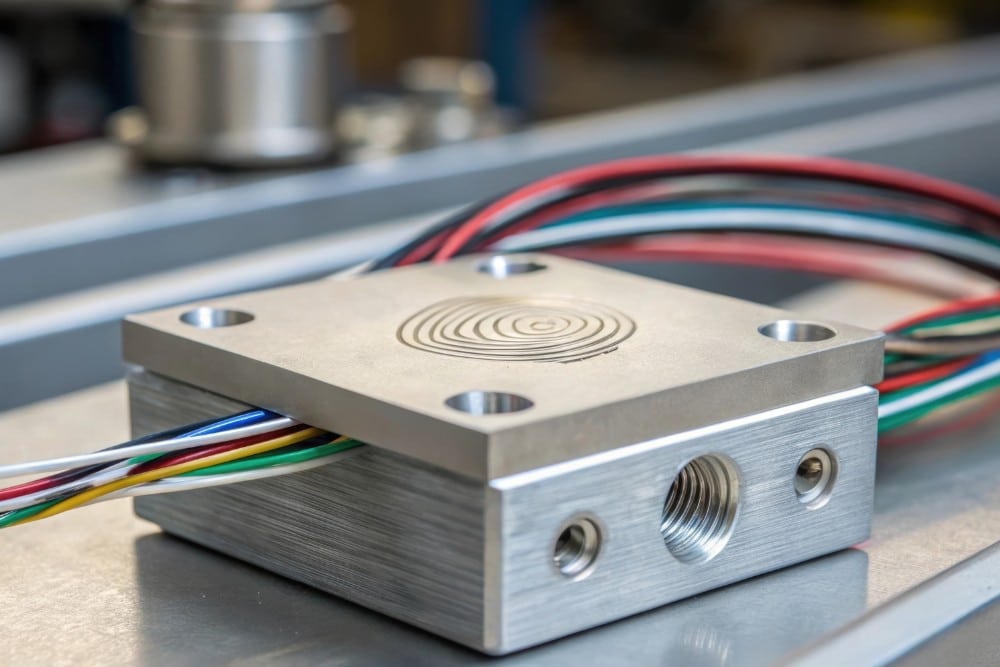
Load cell amplifiers make sure your load cell signals are precise, reliable and easy to read, they are a vital part of any measurement or weighing application. Whether you are in industrial automation, manufacturing or any field where you need accurate force and weight measurement, knowing what to look for in an amplifier can make all the difference.
What is a Load Cell Amplifier?
A load cell is a type of sensor that measures weight or force and converts it into a small electrical signal. But that signal is very weak – too weak for most systems or machines to work with directly.
A load cell amplifier solves this problem by taking that small signal and making it stronger and clearer. This allows the signal to be read by other devices like controllers, data loggers or display screens.
The amplifier is the bridge between the load cell and the rest of the system, making the weight measurement precise and easy to read or use in any application.
How Does a Load Cell Amplifier Work?
A load cell amplifier takes the small electrical signal from a load cell and makes it stronger so it can be read or measured by other devices like controllers, data loggers or display systems.
Here’s how it works:
1. Input Signal from the Load Cell
- The load cell produces a very low level signal, typically in millivolts (mV), proportional to the force or weight applied to it.
- This signal is generated by the change in electrical resistance of the strain gauge within the load cell.
2. Excitation Voltage
- The load cell needs a stable voltage supply, called excitation voltage, to work. The amplifier often provides this excitation voltage to the load cell, so the measurements are consistent and accurate.
3. Gain
- The amplifier takes the small output signal from the load cell and uses internal electronics to boost or amplify it to a higher voltage level (e.g. 0–5V, 0–10V or 4–20mA).
- Makes the signal stronger and easier to read by other systems.
4. Signal Conditioning
- During amplification, the amplifier may also filter out noise (unwanted electrical interference) and stabilize the signal for accuracy.
- Some amplifiers also linearize the signal so the output is directly proportional to the weight or force applied.
5. Output to Other Devices
- The amplified and conditioned signal is sent to other devices like a digital display, PLC (Programmable Logic Controller) or data acquisition system.
- These devices use the amplified signal to show weight, trigger actions or store data.
- The load cell amplifier makes the load cell signal stronger and cleaner so it’s usable for precise measurement in any application.
How to Choose the Right Amplifier for Your Load Cell System
Choosing the right amplifier for your load cell is essential to getting accurate and reliable measurements. Here’s what you should keep in mind:
1. Check Load Cell Compatibility
Make sure the amplifier works with your load cell’s output, usually in millivolts (mV/V), and that it provides the correct excitation voltage for your load cell to operate properly.
2. Understand Output Signal Options
Think about how the amplifier will send data to your system:
- Voltage Output: 0–5V, 0–10V
- Current Output: 4–20mA is great for long-distance signal transmission
- Digital Output: Ideal if you’re working with digital systems or PLCs.
3. Consider Signal Conditioning
A good amplifier should clean up the signal and ensure accuracy by offering:
- Noise Filtering: To reduce any unwanted electrical noise.
- Temperature Compensation: To maintain accuracy even when environmental conditions change.
- Linearization: To ensure the output is directly proportional to the input.
4. Think About Your Environment
Be sure the amplifier can handle your specific application environment—whether it’s hot, humid, dusty, or exposed to outdoor elements.
Ingress Protection (IP) Rating: If your system is in a tough environment, look for an amplifier with a strong IP rating for added durability.
5. Get the Right Accuracy and Resolution
Choose an amplifier that delivers the level of accuracy and resolution your application demands. Higher resolution means you can get more detailed and precise measurements.
6. Look for Easy Integration
Consider how easily the amplifier will fit into your existing setup:
- Mounting: Can it be mounted on a panel, DIN rail, or inline?
- Connectors: Does it have screw terminals, quick-connectors, or custom cabling for your needs?
7. Plan for Scalability and Flexibility
If you think your application might evolve or grow, choose an amplifier that offers adjustable gain or multi-range settings so it can handle different load cells or ranges down the line.
8. Balance Cost and Performance
Find the right balance between your budget and the features you need. If you’re working on a simple project, a basic amplifier might be enough, but for more complex systems, it’s worth investing in a high-performance model.
9. Go with a Trusted Brand
It’s always safer to choose an amplifier from a well-known manufacturer with a good reputation. Look for companies that offer strong customer support, clear documentation, and reliable calibration services.
10. Ensure Standards Compliance
Make sure the amplifier meets the necessary industry standards, especially if you’re working in regulated fields like medical, aerospace, or manufacturing. This ensures your system is safe, reliable, and up to code.
Steps to Follow
1. Identify Your Requirements
Start by listing the technical specifications of your load cell, including output signal, excitation voltage, and environmental factors, along with your system’s specific needs.
2. Compare with Amplifier Options
Match your load cell and system requirements to the amplifier specifications provided by manufacturers, ensuring compatibility and performance.
3. Seek Expert Guidance
If you’re uncertain about compatibility or features, reach out to the manufacturer or supplier for support.
4. Work with Massload for Simplified Solutions
When you choose Massload, the process becomes even easier. Simply share the details of your application, and our experienced engineers will recommend the ideal amplifier for your needs. With over 40 years of expertise in weighing solutions, we’re here to ensure you make the best choice, every time.
Choosing the right amplifier for your load cell system doesn’t have to be hard. Focus on compatibility, performance and your application’s needs and you’ll get accuracy and efficiency.
With the right amplifier your load cell system will perform to the precision and reliability you need even in the toughest environments.
Enhance Your Weight Sensors with the Perfect Amplifier for Your Applications
Choosing the right amplifier for your load cell system doesn’t have to be hard. Focus on compatibility, performance and your application’s needs and you’ll get accuracy and efficiency.
With the right amplifier your load cell system will perform to the precision and reliability you need even in the toughest environments.
At Massload we have a range of high quality load cell amplifiers for various industries. From rugged for harsh environments to amplifiers with advanced signal conditioning we have you covered.
Connect with our expert team today — let us help you find the perfect amplifier to optimize your operations.


